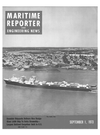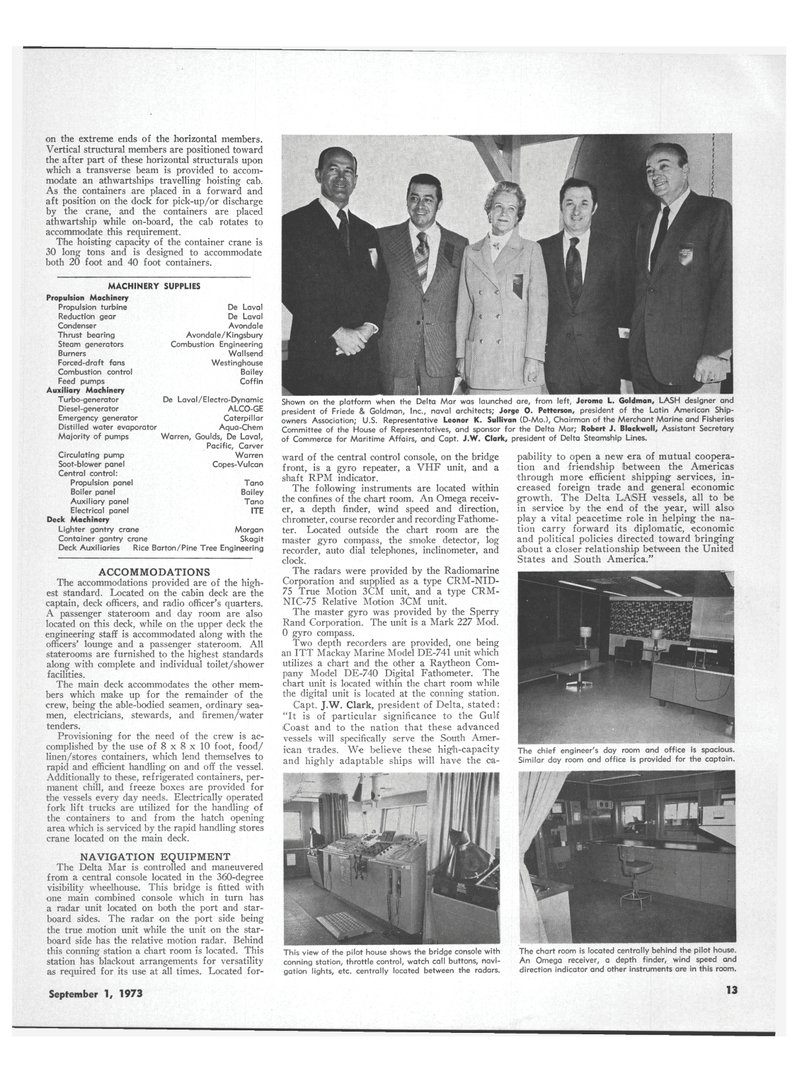
Page 11: of Maritime Reporter Magazine (September 1973)
Read this page in Pdf, Flash or Html5 edition of September 1973 Maritime Reporter Magazine
on the extreme ends of the horizontal members.
Vertical structural members are positioned toward the after part of these horizontal structural upon which a transverse beam is provided to accom- modate an athwartships travelling hoisting cab.
As the containers are placed in a forward and aft position on the dock for pick-up/or discharge by the crane, and the containers are placed athwartship while on-board, the cab rotates to accommodate this requirement.
The hoisting capacity of the container crane is 30 long tons and is designed to accommodate both 20 foot and 40 foot containers.
De Laval
De Laval
Avondale
Avondale/Kingsbury
Combustion Engineering
Wallsend
Westinghouse
Bailey
Coffin
MACHINERY SUPPLIES
Propulsion Machinery
Propulsion turbine
Reduction gear
Condenser
Thrust bearing
Steam generators
Burners
Forced-draft fans
Combustion control
Feed pumps
Auxiliary Machinery
Turbo-generator De Laval/Electro-Dynamic
Diesel-generator ALCO-GE
Emergency generator Caterpillar
Distilled water evaporator Aqua-Chem
Majority of pumps Warren, Goulds, De Laval,
Pacific, Carver
Circulating pump Warren
Soot-blower panel Copes-Vulca
Central control:
Propulsion panel Tano
Boiler panel Bailey
Auxiliary panel Tan
Electrical panel ITE
Deck Machinery
Lighter gantry crane Morgan
Container gantry crane Skagit
Deck Auxiliaries Rice Barton/Pine Tree Engineering
ACCOMMODATIONS
The accommodations provided are of the high- est standard. Located on the cabin deck are the captain, deck officers, and radio officer's quarters.
A passenger stateroom and day room are also located on this deck, while on the upper deck the engineering staff is accommodated along with the officers' lounge and a passenger stateroom. All staterooms are furnished to the highest standards along with complete and individual toilet/shower facilities.
The main deck accommodates the other mem- bers which make up for the remainder of the crew, being the able-bodied seamen, ordinary sea- men, electricians, stewards, and firemen/water tenders.
Provisioning for the need of the crew is ac- complished by the use of 8 x 8 x 10 foot, food/ linen/stores containers, which lend themselves to rapid and efficient handling on and off the vessel.
Additionally to these, refrigerated containers, per- manent chill, and freeze boxes are provided for the vessels every day needs. Electrically operated fork lift trucks are utilized for the handling of the containers to and from, the hatch opening area which is serviced by the rapid handling stores crane located on the main deck.
NAVIGATION EQUIPMENT
The Delta Mar is controlled and maneuvered from a central console located in the 360-degree visibility wheelhouse. This bridge is fitted with one main combined console which in turn has a radar unit located on both the port and star- board sides. The radar on the port side being the true motion unit while the unit on the star- board side has the relative motion radar. Behind this conning station a chart room is located. This station has blackout arrangements for versatility as required for its use at all times. Located for-
Shown on the platform when the Delta Mar was launched are, from left, Jerome L. Goldman, LASH designer and president of Friede & Goldman, Inc., naval architects; Jorge O. Petterson, president of the Latin American Ship- owners Association; U.S. Representative Leonor K. Sullivan (D-Mo.), Chairman of the Merchant Marine and Fisheries
Committee of the House of Representatives, and sponsor for the Delta Mar; Robert J. Blackwell, Assistant Secretary of Commerce for Maritime Affairs, and Capt. J.W. Clark, president of Delta Steamship Lines. ward of the central control console, on the bridge front, is a gyro repeater, a VHF unit, and a shaft RPM indicator.
The following instruments are located within the confines of the chart room. An Omega receiv- er, a depth finder, wind speed and direction, chrometer, course recorder and recording Fathome- ter. Located outside the chart room are the master gyro compass, the smoke detector, log recorder, auto dial telephones, inclinometer, and clock.
The radars were provided by the Radiomarine
Corporation and supplied as a type CRM-NID- 75 True Motion 3CM unit, and a type CRM-
NIC-75 Relative Motion 3CM unit.
The master gyro was provided by the Sperry
Rand Corporation. The unit is a Mark 227 Mod. 0 gyro compass.
Two depth recorders are provided, one being an ITT Mackay Marine Model DE-741 unit which utilizes a chart and the other a Raytheon Com- pany Model DE-740 Digital Fathometer. The chart unit is located within the chart room while the digital unit is located at the conning station.
Capt. J.W. Clark, president of Delta, stated: "It is of particular significance to the Gulf
Coast and to the nation that these advanced vessels will specifically serve the South Amer- ican trades. We believe these high-capacity and highly adaptable ships will have the ca- pability to open a new era of mutual coopera- tion and friendship (between the Americas •through more efficient shipping services, in- creased foreign trade and general economic growth. The Delta LASH vessels, all to be in service by the end of the year, will also play a vital peacetime role in helping the na- tion carry forward its diplomatic, economic and political policies directed toward bringing about a closer relationship between the United
States and South America." mrmM f ''^jJKmmrnm ^^^MsjBljiHiWj,. ( * f 1 I
The chief engineer's day room and office is spacious.
Similar day room and office is provided for the captain.
This view of the pilot house shows the bridge console with conning station, throttle control, watch call buttons, navi- gation lights, etc. centrally located between the radars.
The chart room is located centrally behind the pilot house.
An Omega receiver, a depth finder, wind speed and direction indicator and other instruments are in this room.
September 1, 1973 13

 10
10

 12
12
